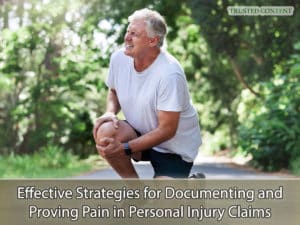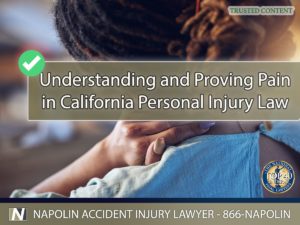Understanding and Proving Pain in California Personal Injury Law
In the realm of personal injury law, the concept of pain, both physical and psychological, plays a pivotal role. In California, where personal injury law is governed by both statutory and case law, the challenge lies in the subjective nature of pain and its legal validation. This article aims to provide a comprehensive understanding of how pain is approached and proven in California's personal injury claims, reflecting the state's legal standards and practices.

Comprehensive Overview of Personal Injury Law in California
Comprehensive Overview of Personal Injury Law in California
Personal injury law in California is designed to provide relief to individuals who have suffered harm due to the negligence or intentional actions of others. This includes a wide array of incidents, from vehicular accidents to workplace injuries. Under California Civil Code Section 3281, “Every person who suffers detriment from the unlawful act or omission of another, may recover from the person in fault a compensation therefor in money, which is called damages.” This law sets the foundation for personal injury claims in the state.
Detailed Exploration of Pain in Personal Injury Claims
Pain, as a component of personal injury claims, is multifaceted. It includes physical pain stemming from the injury and emotional distress caused by the incident or the injury itself. California law recognizes both these aspects, but proving them requires a nuanced approach. The challenge lies in translating the subjective experience of pain into quantifiable terms that can be legally recognized and compensated.
Legal Standards for Assessing Pain in California
In California, the legal framework for assessing pain in personal injury cases is grounded in both statutory law and judicial precedents. The jury instructions, as per the Judicial Council of California Civil Jury Instructions (CACI), provide guidance on evaluating pain and suffering. These instructions emphasize the consideration of the nature of the injury, the duration of pain, and the potential for ongoing discomfort.

Effective Strategies for Documenting and Proving Pain in Personal Injury Claims
Effective Strategies for Documenting and Proving Pain in Personal Injury Claims
Documenting and proving pain in a personal injury case requires a strategic approach. This includes maintaining comprehensive medical records that detail the nature of the injury, treatments received, and descriptions of pain over time. Additionally, testimonies from medical experts and psychologists can provide crucial insights into the extent of the pain suffered and its impact on the claimant's life.
Role of Medical Evidence and Expert Testimony
Medical evidence plays a critical role in substantiating claims of pain in personal injury cases. This evidence, coupled with expert testimony, can provide the objective basis needed to validate the subjective experience of pain. Expert witnesses are often called upon to provide specialized knowledge that can help the jury understand the medical aspects of the pain suffered.
Napolin Accident Injury Lawyer's Comprehensive Approach
At Napolin Accident Injury Lawyer, we approach each personal injury case with a comprehensive understanding of California's legal landscape. Our methodology involves a thorough analysis of the incident, detailed documentation of the client's pain and suffering, and collaboration with medical professionals to build a robust case that accurately represents the client's experiences.

Understanding and Proving Pain in California Personal Injury Law
Understanding and Proving Pain in California Personal Injury Law
Navigating the complexities of personal injury law in California, especially when it comes to proving pain, requires skilled legal representation. If you or a loved one is grappling with the aftermath of an injury, reach out to Napolin Accident Injury Lawyer at (909) 962-8415. With our extensive litigation experience and deep understanding of California law, we are committed to ensuring that your pain is recognized and justly compensated. Contact us for a free consultation and take the first step towards securing the support and compensation you deserve.

 How can I help you?
How can I help you?